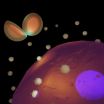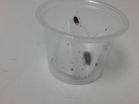UAlberta prostate cancer researcher and team developing 'homing beacon drugs' to target cancer cells
2012-11-21
(Press-News.org) A medical researcher with the University of Alberta and his team just published their findings about their work on developing 'homing beacon drugs' that kill only cancer cells, not healthy ones, thanks to nano-technology.
John Lewis, the Frank and Carla Sojonky Chair in Prostate Cancer Research with the Faculty of Medicine & Dentistry, published his findings in the peer-reviewed journal, Nano Letters. He is also an associate professor in the Department of Oncology, a Fellow with the National Institute for Nanotechnology at the U of A and director of the Translational Prostate Cancer Research Group.
Lewis noted chemotherapy goes through the body and kills any cells that are dividing, even healthy ones – which is why cancer patients have immune system problems, hair loss, nausea and skin problems.
"We are developing smart drugs that determine which are the cancer cells and which aren't, then selectively kill only the cancer cells. The drugs look for a protein that is only found in cancer cells, not normal cells. This system acts like a homing beacon for tumours."
These drugs, tested to date in only animal lab models, could be used within a week of cancer diagnoses, predicts Lewis. The drugs would target cancerous cells throughout the body – attacking sneaky cancer cells that have already escaped and grown outside the site of the main tumour.
Lewis wasn't sure when these homing beacon drugs could be available for physicians to use with patients, but hopes his works paves the way for patient-centered therapies.
"If we can use 'smart' drugs that home in on tumours, we can dramatically decrease side effects for patients, lower the chance of recurrence, and hopefully increase the cancer survival rate."
Meanwhile, Lewis and his research team are continuing their work on trying to figure out what causes cancer cells to escape and spread from the main tumour site because the cells that move are different than the ones in the main tumour. They have pinpointed numerous genes that set these 'moving' cancer cells apart from the ones that stay put. Based on this research, they have come up with a drug that uses a 'tumour glue' to prevent these moving cancer cells from breaking apart from the main tumour, which prevents the spread of the cancer. Using knowledge gained from the 'tumour glue' drug, Lewis and his team are working to develop new blood tests to predict whether prostate and other cancers will spread.
### END
ELSE PRESS RELEASES FROM THIS DATE:
2012-11-21
This press release is available in German.
Flowers need water and light to grow. Even children learn that plants use sunlight to gather energy from earth and water. Members of Professor Dr. Olaf Kruse's biological research team at Bielefeld University have made a groundbreaking discovery that one plant has another way of doing this. They have confirmed for the first time that a plant, the green alga Chlamydomonas reinhardtii, not only engages in photosynthesis, but also has an alternative source of energy: it can draw it from other plants. This finding could also have ...
2012-11-21
CHESTNUT HILL, MA (Nov. 20, 2012) – The executive pay provisions of the TARP – the Troubled Asset Relief Program – stoked controversy. Bankers claimed the rules would thwart their efforts to attract and retain the best executives. But the pay rules may have had an unintended benefit of reducing the scope of the program, researchers say.
A newly published report in the Journal of Banking, Finance & Accounting finds that pay provisions did discourage some banks from participating in TARP, which was intended to help banks weather the 2008-2009 financial crisis, according ...
2012-11-21
Some grey seal mums adopt risky tactics when it comes to the future of their young, a strategy that can give their pup a real advantage, according to scientists.
Researchers from Durham University, UK, and the University of St Andrews, looking at grey seal colonies in Scotland, found that some seal mothers are flexible in the parenting style they adopt and 'gamble' on the outcome of their actions, whilst other play it safe and steady.
The study is the first to demonstrate how variation in personality traits in large marine mammals in the wild can persist, rather than ...
2012-11-21
WASHINGTON, Nov. 20, 2012 — The American Chemical Society (ACS) today launched a new video series that highlights headline-making research from the society's suite of more than 40 peer-reviewed scientific journals. The first episode of Breakthrough Science focuses on research reported in one of those journals, ACS Nano. It involved development of new transparent solar cells, an advance toward giving windows in homes and other buildings the ability to generate electricity while still allowing people to see outside.
The video is available at http://pubs.acs.org/page/videos/breakthroughscience.html.
Breakthrough ...
2012-11-21
Providence, RI - - Electroconvulsive therapy (ECT) is considered the most effective treatment option for patients with severe depression who cannot find symptom relief through antidepressant medications or psychotherapy. In a new study, researchers at Butler Hospital and Bradley Hospital in Rhode Island found a sharp decline in the availability and use of ECT in general hospitals across the U.S. The findings were published online in the journal Biological Psychiatry on October 10, 2012.
The researchers analyzed data from a nationally representative survey of US general ...
2012-11-21
Health professionals may soon have a new method of diagnosing Parkinson's disease, one that is noninvasive and inexpensive, and, in early testing, has proved to be effective more than 90 percent of the time.
In addition, this new method has the potential to track the progression of Parkinson's, as well as measure the effectiveness of treatments for the disorder, said Rahul Shrivastav, professor and chairperson of Michigan State University's Department of Communicative Sciences and Disorders and a member of the team developing the new method.
It involves monitoring a ...
2012-11-21
Called BRIGHTs, the tiny probes described in the online issue of Advanced Materials on Nov. 15, bind to biomarkers of disease and, when swept by an infrared laser, light up to reveal their location.
Tiny as they are, the probes are exquisitely engineered objects: gold nanoparticles covered with molecules called Raman reporters, in turn covered by a thin shell of gold that spontaneously forms a dodecahedron.
The Raman reporters are molecules whose jiggling atoms respond to a probe laser by scattering light at characteristic wavelengths.
The shell and core create an ...
2012-11-21
The risk of developing pelvic inflammatory disease (PID) following insertion of an intrauterine device (IUD) is very low, whether or not women have been screened beforehand for gonorrhea and chlamydia, according to a joint study of nearly 60,000 women by researchers at the University of California, San Francisco (UCSF), and Kaiser Permanente Northern California Division of Research.
The study appears this week in the current online issue of Obstetrics & Gynecology, the official journal of the American College of Obstetricians and Gynecologists, also known as Green Journal.
The ...
2012-11-21
WINSTON-SALEM, N.C., – Nov. 20, 2012 – Researchers at Wake Forest Baptist Medical Center have modified electrically-conductive polymers, commonly used in solar energy applications, to develop revolutionary polymer nanoparticles (PNs) for a medical application. When the nanoparticles are exposed to infrared light, they generate heat that can be used to kill colorectal cancer cells.
The study was directed by Assistant Professor of Plastic and Reconstructive Surgery, Nicole H. Levi-Polyachenko, Ph.D., and done in collaboration with colleagues at the Center for Nanotechnology ...
2012-11-21
UNIVERSITY PARK, Pa. -- "And don't let the bed bugs bite" is no longer a harmless adage. In reality today, these bloodthirsty bugs infest thousands of homes. According to a team of Penn State entomologists, biopesticides -- naturally occurring microorganisms -- might provide an answer to this pest problem.
Bed bugs need blood meals for growth and development throughout their life cycle. Increased travel, widespread insecticide resistance and changes in management practices have caused a resurgence in those insects throughout North America and Europe. Compounding the problem ...
LAST 30 PRESS RELEASES:
[Press-News.org] UAlberta prostate cancer researcher and team developing 'homing beacon drugs' to target cancer cells




